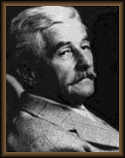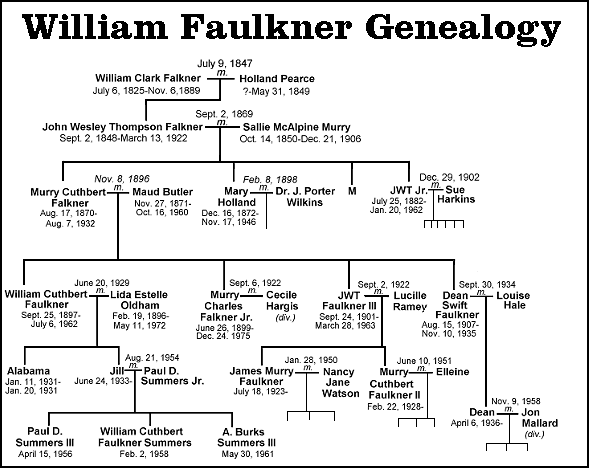Menu
Beers
Newsletter
Merchandise
Brewing Process
Directions
Contact Us
William Faulkner
Blue Ridge Brewing Company
709 West Main Street, Charlottesville, VA 22903, (804) 977-0017
Paul and Bok Summers, owners of the Blue Ridge Brewery,
are great-grandsons of the famous William Faulkner.

William Faulkner (1897-1962), American novelist, known for his epic portrayal, in some 20 novels, of the tragic conflict between the old and the new South. Faulkner's complex plots and narrative style alienated many readers of his early works, but he was recognized later as one of the greatest American writers.
Born in New Albany, Mississippi, Faulkner was raised in nearby Oxford as the oldest of four sons of an old-line southern family. In 1915 he dropped out of high school, which he detested, to work in his grandfather's bank. In World War I (1914-1918) he joined the Royal Canadian Air Force but never saw battle action. Back home in Oxford, he was admitted to the University of Mississippi as a veteran, but he soon quit school to write, supporting himself with odd jobs.
Faulkner's first book, The Marble Faun, a collection of pastoral poems, was privately printed in 1924. The following year he moved to New Orleans, worked as a journalist, and met the American short-story writer Sherwood Anderson, who helped him find a publisher for his first novel, Soldier's Pay (1926), and also convinced him to write about the people and places he knew best. After a brief tour of Europe, Faulkner returned home and began his series of baroque, brooding novels set in the mythical Yoknapatawpha County (based on Lafayette County, Mississippi), peopling it with his own ancestors, Native Americans, blacks, shadowy backwoods hermits, and loutish poor whites. In the first of these novels, Sartoris (1929), he patterned the character Colonel Sartoris after his own great-grandfather, William Cuthbert Falkner, a soldier, politician, railroad builder, and author. (Faulkner restored the "u" that had been removed from the family name.)
The year 1929 was crucial to Faulkner. That year Sartoris was followed by The Sound and the Fury, an account of the tragic downfall of the Compson family. The novel uses four different narrative voices to piece together the story and thus challenges the reader by presenting a fragmented plot told from multiple points of view. The structure of The Sound and the Fury presaged the narrative innovations Faulkner would explore throughout his career. Also in 1929 Faulkner married his childhood sweetheart, Estelle Oldham, and made his home in the small town of Oxford, Mississippi. Most of the books he wrote over the rest of his life received favorable reviews, but only one, Sanctuary (1931), sold well. Despite its sensationalism and brutality, its underlying concerns were with corruption and disillusionment. The book's success led to lucrative work as a scriptwriter for Hollywood, which, for a short time, freed Faulkner to write his novels as his imagination dictated. Faulkner's two most successful screenplays were written for movies that were directed by Howard Hawks: To Have and Have Not (1945, adapted from the novel by the American writer Ernest Hemingway) and The Big Sleep (1946, adapted from the novel by the American writer Raymond Chandler).
Faulkner's works demanded much of his readers. To create a mood, he might let one of his complex, convoluted sentences run on for more than a page. He juggled time, spliced narratives, experimented with multiple narrators, and interrupted simple stories with rambling, stream-of-consciousness soliloquies. Consequently, his readership dwindled. In 1946 the critic Malcolm Cowley, concerned that Faulkner was insufficiently known and appreciated, put together The Portable Faulkner, arranging extracts from Faulkner's novels into a chronological sequence that gave the entire Yoknapatawpha saga a new clarity, thus making Faulkner's genius accessible to a new generation of readers. Faulkner's works, long out of print, began to be reissued. No longer was he regarded as a regional curiosity, but as a literary giant whose finest writing held meaning far beyond the agonies and conflicts of his own troubled South. His accomplishment was internationally recognized in 1949, when he was awarded the Nobel Prize in literature. His major works include As I Lay Dying (1930), the story of a family's journey to bury a mother; Light in August (1932); Absalom, Absalom! (1936), about Thomas Sutpen's attempt to found a Southern dynasty; The Unvanquished (1938); The Hamlet (1940), the first novel in a trilogy about the rise of the Snopes family; Go Down Moses (1942), a collection of Yoknapatawpha County stories of which "The Bear" is the best known; Intruder in the Dust (1948); A Fable (1954); The Town (1957) and The Mansion (1959), which completed the Snopes trilogy; and The Reivers (1962). Faulkner especially was interested in multigenerational family chronicles, and many characters appear in more than one book; this gives the Yoknapatawpha County saga a sense of continuity that makes the area and its inhabitants seem real. Faulkner continued to write-both novels and short stories-until his death.

fatpat Software · PO Box 1785 · Charlottesville, VA 22902 · (804) 977-1652
